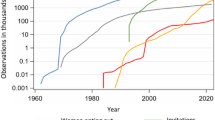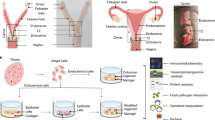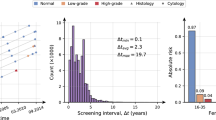Abstract
Mass screening for cervical cancer precursors has decreased the incidence of cervical cancer in several countries, including the Netherlands. Persistent infections of certain types of human papillomavirus are strongly associated with the development of cervical cancer. A number of factors may affect the liability to infection and subsequent progression to cervical intraepithelial neoplasia and cancer. This paper examines whether genetic factors are involved in explaining individual differences in liability. Data of 3178 women registered with the Netherlands Twin Register were successfully linked to the nationwide Dutch Pathology database that contains all results of mass screening for cervical cancer. The data from mono- and dizygotic twins and their female relatives were used to disentangle the influence of heritable and environmental factors on cervix smear abnormalities. Results showed that differences in cervix smear results clustered within families and resemblance was stronger in monozygotic twins (correlation 0.37, 95% confidence interval: 0.12–0.58) compared with other first-degree relatives (correlation 0.14, 95% confidence interval: −0.01–0.29). The familial clustering for an abnormal cervix smear is due to shared genetic factors that explain 37% of the variance in liability. The largest proportion of the variation in cervical smear abnormalities is due to unique environmental factors.
Similar content being viewed by others
Log in or create a free account to read this content
Gain free access to this article, as well as selected content from this journal and more on nature.com
or
References
Anttila A, Ronco G, Clifford G et al: Cervical cancer screening programmes and policies in 18 European countries. Br J Cancer 2004; 91: 935–941.
Gustafsson L, Ponten J, Zack M, Adami HO : International incidence rates of invasive cervical cancer after introduction of cytological screening. Cancer Causes Control 1997; 8: 755–763.
Yoder L, Rubin M : The epidemiology of cervical cancer and its precursors. Oncol Nurs Forum 1992; 19: 485–493.
Van der Aa MA, Pukkala E, Coebergh JW, Anttila A, Siesling S : Mass screening programmes and trends in cervical cancer in Finland and the Netherlands. Int J Cancer 2008; 122: 1854–1858.
Boot HJ, Wallenburg I, Melker HE et al: Assessing the introduction of universal human papillomavirus vaccination for preadolescent girls in The Netherlands. Vaccine 2007; 25: 6245–6256.
Couto E, Hemminki K : Heritable and environmental components in cervical tumors. Int J Cancer 2006; 119: 2699–2701.
Hemminki K, Chen B : Familial Risks for Cervical Tumors in Full and Half Siblings: Etiologic Apportioning. Cancer Epidemiol Biomarkers Prev 2006; 15: 1413–1414.
Hemminki K, Li X, Mutanen P : Familial risks in invasive and in situ cervical cancer by histological type. Eur J Cancer Prev 2001; 10: 83–89.
Magnusson PKE, Lichtenstein P, Gyllensten UB : Heritability of cervical tumours. Int J Cancer 2000; 88: 698–701.
Zelmanowicz AM, Schiffman M, Herrero R et al: Family history as a co-factor for adenocarcinoma and squamous cell carcinoma of the uterine cervix: results from two studies conducted in Costa Rica and the United States. Int J Cancer 2005; 116: 599–605.
Lichtenstein P, Holm NV, Verkasalo PK et al: Environmental and Heritable Factors in the Causation of Cancer – Analyses of Cohorts of Twins from Sweden, Denmark, and Finland. N Engl J Med 2000; 343: 78–85.
Ahlbom A, Lichtenstein P, Malmstrom H, Feychting M, Hemminki K, Pedersen NL : Cancer in twins: genetic and nongenetic familial risk factors. J Natl Cancer Inst 1997; 89: 289–293.
Boomsma DI, Vink JM, van Beijsterveldt CEM et al: Netherlands Twin Register: a focus on longitudinal research. Twin Res 2002; 5: 401–406.
Casparie M, Tiebosch A, Burger G et al: Pathology databanking and biobanking in The Netherlands a central role for PALGA, the nationwide histopathology and cytopathology data network and archive. Cellular Oncology 2007; 29: 19–24.
van Ballegooijen M, Hermens R : Cervical cancer screening in the Netherlands. European Journal of Cancer 2000; 36: 2244–2246.
Rebolj M, Van Ballegooijen M, Berkers LM, Habbema D : Monitoring a national cancer prevention program: successful changes in cervical cancer screening in the Netherlands. Int J Cancer 2006; 120: 806–812.
Boomsma DI, de Geus EJC, Vink JM et al: Netherlands Twin Register: from twins to twin families. Twin Research and Human Genetics 2006; 9: 849–857.
Bulk S, van Kemenade FJ, Rozendaal L, Meijer CJLM : The Dutch CISOA-A framework for cytology reporting increases efficacy of screening upon standardisation since 1996. J Clin Pathol 2004; 57: 388–393.
Falconer DS, Mackay TFC : Treshold Characters (Chapter 18), in Quantitative Genetics. Longman Group Ltd.: Essex, 1996.
Neale MC, Boker SM, Xie G, Maes HH : Mx: Statistical Modeling. 5th edn. VCU Box 900126: Richmond, VA 23298, 1999.
Boomsma DI, Busjahn A, Peltonen L : Classical twin studies and beyond. Nat Rev Genet 2002; 3: 872–882.
Gök M, Heideman DA, van Kemenade FJ et al: HPV testing on self collected cervicovaginal lavage specimens as screening method for women who do not attend cervical screening: cohort study. Britisch Medical Journal 2010; 11: c1040.
McCredie MR, Sharples KJ, Paul D et al: Natural history of cervical neoplasia and risk of invasive cancer in women with 3: a retrospective cohort study. Lancet Oncol 2008; 9: 425–434.
Czene K, Lichtenstein P, Hemminki K : Environmental and heritable causes of cancer among 9.6 million individuals in the swedish family-cancer database. Int J Cancer 2002; 99: 260–266.
Ho GY, Bierman R, Beardsley L, Chang CJ, Burk RD : Natural history of cervicovaginal papillomavirus infection in young women. N Engl J Med 1998; 338: 423–428.
Nobbenhuis MA, Helmerhorst TJ, van den Brule AJ et al: Cytological regression and clearance of high-risk human papillomavirus in women with an abnormal cervical smear. The Lancet 2001; 358: 1782–1783.
de Araujo Souza PS, Villa LL : Genetic susceptibility to infection with human papillomavirus and development of cervical cancer in women in Brazil. Muation Research 2003; 544: 375–383.
Koshiol J, Hildesheim A, Gonzalez P et al: Common Genetic Variation in TP53 and Risk of Human Papillomavirus Persistence and Progression to CIN3/Cancer Revisited. Cancer Epidemiol Biomarkers Prev 2009; 18: 1631–1637.
Simões RT, Gonçalves MA, Castelli EC et al: HLA-G polymorphisms in women with squamous intraepithelial lesions harboring human papillomavirus. Mod Pathol 2009; 22: 1075–1082.
Au WW : Life style, environmental and genetic susceptibility to cervical cancer. Toxicology 2004; 198: 117–120.
Nishino K, Sekine M, Kodama S et al: Cigarette smoking and glutathione S-transferase M1 polymorphism associated with risk for uterine cervical cancer. J Obstet Gynaecol Res 2008; 34: 994–1001.
Bosch FX, de Sanjose S : The epidemiology of human papillomavirus infection and cervical cancer. Dis markers 2007; 23: 213–227.
Cotton SC, Sharp L, Masson LF et al: Lifestyle and socio-demographic factors associated with high-risk HPV infection in UK women. Br J Cancer 2007; 97: 133–139.
Vink JM, Willemsen G, Boomsma DI : Heritability of smoking initiation and nicotine dependence. Behav Genet 2005; 35: 397–406.
Stubbe JH, Boomsma DI, Vink JM et al: Genetic influence on exercise participation in 37,051 twin pairs from seven countries. PLos ONE 2006; 20: e22.
Verweij K, Zietsch BP, Bailey JM, Martin NG : Shared etiology of risky sexual behaviour and adolescent misconduct: genetic and environmental influences. Genes, Brains and Behavior 2009; 8: 107–113.
Zietsch BP, Verweij K, Bailey AJ, Wright MJ, Martin NG : Genetic and environmental influences on risky sexual behavior and its relationship with personality. Behav Genet 2010; 40: 12–21.
Acknowledgements
This work was supported by the Netherlands Organization for Scientific Research (NWO-MW 904-61-193; NWO/SPI 56-464-14192 to DB; NWO 480-04-004; NWO-VENI 451-06-004 to JV).
Author information
Authors and Affiliations
Corresponding author
Ethics declarations
Competing interests
The authors declare no conflict of interest.
Rights and permissions
About this article
Cite this article
Vink, J., van Kemenade, F., Meijer, C. et al. Cervix smear abnormalities: linking pathology data in female twins, their mothers and sisters. Eur J Hum Genet 19, 108–111 (2011). https://doi.org/10.1038/ejhg.2010.139
Received:
Revised:
Accepted:
Published:
Issue date:
DOI: https://doi.org/10.1038/ejhg.2010.139
Keywords
This article is cited by
-
Single nucleotide polymorphisms in PDCD6 gene are associated with the development of cervical squamous cell carcinoma
Familial Cancer (2015)
-
Genetic susceptibility to cervical cancer: role of common polymorphisms in apoptosis-related genes
Tumor Biology (2015)
-
MDM2 polymorphism associated with the development of cervical lesions in women infected with Human papillomavirus and using of oral contraceptives
Infectious Agents and Cancer (2014)
-
The continuing value of twin studies in the omics era
Nature Reviews Genetics (2012)



